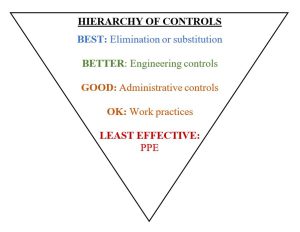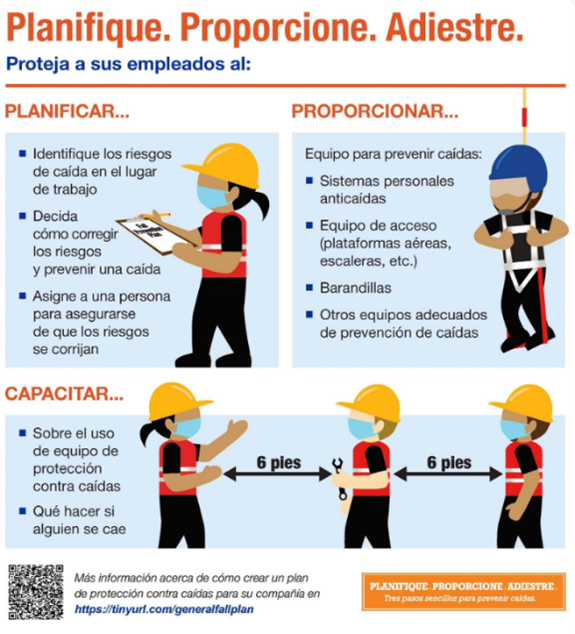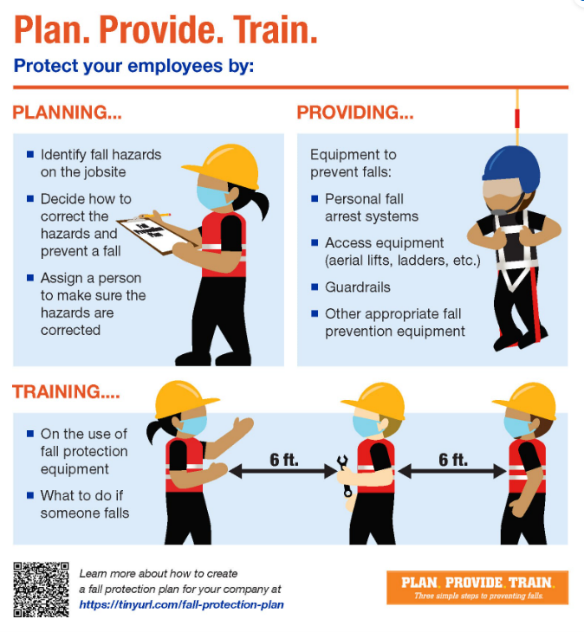Standing Down to Prevent Falls in Construction
Posted on by Overview
Overview
Construction workers are at risk for injuries from many sources, but falls continue to be the leading cause of death (accounting for 37% [379 out of the 1015 fatalities] of all construction fatalities in 2021). This year marks the 10th annual National Safety Stand-Down to prevent falls in construction, an event to raise awareness that falls among construction workers are preventable. Read further to learn more about the 2023 Stand-Down and how employers, frontline workers, and safety and health professionals can all work to prevent falls in construction.
National Safety Stand-Down to Prevent Falls in Construction
The annual Stand-Down event is part of the National Campaign to Prevent Falls in Construction. It is a one-week, nationwide event organized by the Occupational Safety and Health Administration (OSHA), the National Institute for Occupational Safety and Health (NIOSH), and The Center for Construction Research and Training (CPWR) to raise awareness of slip, trip, and fall hazards and prevent fall injuries and fatalities. Safety Stand-Downs are voluntary events for employers to talk directly to employees about safety. The Falls Stand-Down is an opportunity to distribute educational materials, train workers, and discuss your company’s safety policies and goals. Information geared specifically toward small contractors is available.
This year, the 10th annual National Safety Stand-Down to Prevent Falls in Construction will occur May 1-5, 2023. Companies that participate in the 2023 Stand-Down can receive an OSHA Certificate of Participation. Employers can order FREE pocket-sized Hazard Alert Cards on a variety of fall-related topics from CPWR while supplies last.
Stand-Down Activities
Stay tuned to OSHA’s Stand-Down event webpage for free events taking place in your area during the week of May 1-5. CPWR, NIOSH, and OSHA already hosted a Falls Campaign webinar in support of the upcoming Stand-Down, Preventing Falls through Improved Design, which focused on prevention through design or designing buildings, work, and equipment with safety in mind. That recording, along with other past webinars, is available on stopconstructionfalls.com. Campaign partners will also hold a Spanish-language webinar on April 26 at 2 p.m. for the 2023 National Stand-Down that will focus on safe use of personal fall arrest systems and rescue planning. Register here.
For information on Stand-Down trends over the last decade, including summaries of past participant engagement and feedback used to improve the event every year, please visit the Stand-Down evaluation efforts page.
We’d love to see what your company does to participate in the Stand-Down this year! Engage with others and share your activities on social media using the hashtag: #StandDown4Safety.
_______________________________________________________________________________
Falls are Preventable
Like all occupational hazards, the prevention of falls should follow the hierarchy of controls, a system that ranks hazard controls from most to least effective risk reduction. Below are examples of applying the hierarchy of controls to prevent falls in construction. Examples are given from most effective to least effective.
- Elimination: Reducing the time spent working at heights as much as possible Prefabricate when possible to avoid extended work at heights
- Substitution: Replacing ladders with lifts and pre-installation of stairs
- Engineering Controls: Installing guardrails and roof edges, and using hoists
- Administrative controls and work practices: rotating jobs to reduce worker exposures, taking breaks, having a buddy system
- Personal Protective Equipment (PPE): Using harnesses and lifelines when appropriate
The Prevention Through Design (PtD) approach is consistent with the hierarchy of controls and involves plans to ‘design out’ potential hazards to help prevent falls in construction. There is also a Fall Prevention Checklist for Architects and Design Engineers to prevent common fall exposures during commercial construction and building maintenance. Make sure to check it out.


Increased Risk of Fatalities Among Hispanic Workers
Falls represent the greatest cause of death among construction workers. Hispanic workers now make up over 32% of the construction workforce, have a fatal injury rate 42% higher than non-Hispanic workers, and face a disproportionate burden of fatalities from falls.
Research and Efforts to Address the Increased Risks
Researchers are trying to shed light on why Hispanic construction workers are more likely to fall and die on the job. For example, workers report that: (a) there is often a fear of retaliation if safety concerns were raised; (b) being paid by the job (not hourly) is at odds with working safely; and (c) many small contractors work on volume, which tends to prioritize working fast to complete each job [1, 2]. A 2009 pilot study identified a lack of understanding of construction and safety terminology as an important limitation to safety training among Hispanic construction workers [3]. Recognizing the importance of language barriers, OSHA, NIOSH, and CPWR have recently developed a new series of infographics focusing on preventing construction falls with training materials available in up to 10 different languages. Additionally, research among workers in small residential construction companies has demonstrated the need to include both employers and their workers in the identification and implementation of strategies to improve safety in small construction workplaces [4].
CPWR maintains a website which has tools, information, and resources, including a generic fall protection and rescue planning template, social media messaging, and other educational materials. The materials are specifically designed to reach groups at high-risk for falls (including those at small construction worksites) and most are available in English and Spanish. The site also has a collection of resources in other languages such as Polish, Portuguese, and Vietnamese. OSHA also provides fall prevention resources in English and Spanish; the OSHA site links to resources in other languages as well. Additional resources are listed below.
Hosting a Safety Stand-Down at Your Workplace
Hosting annual Safety Stand-Down events at your workplace provides an opportunity to conduct both new and refresher training, offer a safe space for workers to ask questions, and provide them with safety information and resources in Spanish and English. Companies can conduct a Safety Stand-Down by taking a break to have a toolbox talk or other safety activities such as conducting safety equipment inspections, engaging in fall protection demonstrations or harness fit testing, developing rescue plans, and discussing jobsite specific hazards. Some relevant resources include:
- About the Stand-Down
- CPWR’S One Stop Stand-Down Shop on StopConstructionFalls.com
- Suggestions to prepare successful Stand-Downs
- Highlights from previous Stand-Downs
- OSHA Regional Coordinators for more information
- OSHA Certificates of Participation
- and an Evaluation Efforts page for recommendations on how to improve your Stand-Down event and increase engagement with workers
Share your Stand-Down event success stories with us by filling out this form; you could be featured on the Success Stories page. Fall Safety is a year-long initiative not just a one-week event. Check out the 10 Ways to Keep Your Fall Prevention Alive All Year Long for ideas on how to keep the protection initiative going.
Useful Tools and Resources
For the most current construction specific data, access CPWR’s Data Reports and interactive Data Dashboards. Here are some general tools that are available in English and Spanish:
- Construction FACE Database
- Infographics and Toolbox talks:
- Other resources including apps, and tools:
- Resources for Employers and Employees | Occupational Safety and Health Administration (osha.gov)
- Training and other resources

- Developing plans to prevent falls
- NIOSH Ladder safety app: Falls in the Workplace: Ladder Safety Mobile App | NIOSH | CDC
- NIOSH Aerial Lift Simulator
- Online tool: Falls in the Workplace: Mast Climbing Work Platforms | NIOSH | CDC
- Experts weigh in on bilingual best practices for jobsites | 2018-02-14 | ENR | Engineering News-Record
- Latino Worker Safety Center Refresher Video
Mirle Pena, MS, is the Assistant Coordinator for the NORA Construction Sector.
Jessica Bunting, MPH, is the Research to Practice Director at CPWR – The Center for Construction Research and Training (CPWR).
CDR Elizabeth Garza, MPH, CPH, is Coordinator for the Construction Program in the Office of Construction Safety and Health at NIOSH.
Douglas Trout, MD, MHS, is Deputy Director, Office of Construction Safety and Health at NIOSH.
Asha Brogan, MS, is a Heath Commutation Fellow in the NIOSH Division of Field Studies & Engineering.
Scott Breloff, Ph.D. is a Senior Industrial Research Engineer in the Division of Field Studies & Engineering and the Co-Coordinator for the Construction Program in the Office of Construction Safety and Health at NIOSH.
Scott Earnest, PhD, PE, CSP, is the Associate Director for the NIOSH Office of Construction Safety and Health.
References
- Roelofs, C., et al., A qualitative investigation of Hispanic construction worker perspectives on factors impacting worksite safety and risk. Environmental Health: A Global Access Science Source, 2011. 10(1).
- Montgomery, S., et al., Work Ethic and Cognitive Models of Work: Contractors and Workers Perspectives on Elevated Injury and Fatality among Latino Workers in Small- Scale Residential Construction. 2021.
- McGlothlin, J., et al., Ergonomics. Journal of Occupational and Environmental Hygiene, 2009. 6(9): p. D45-D50.
- Grzywacz, J., et al., Elevated Injury among Latino Workers in Small-Scale Residential Construction: Contractor and Worker Perspectives. 2021.
Posted on by

